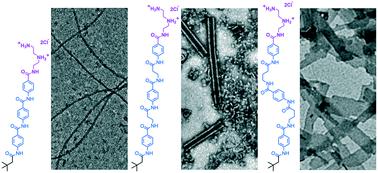当前位置:
X-MOL 学术
›
Mol. Syst. Des. Eng.
›
论文详情
Our official English website, www.x-mol.net, welcomes your
feedback! (Note: you will need to create a separate account there.)
Effects of molecular flexibility and head group repulsion on aramid amphiphile self-assembly
Molecular Systems Design & Engineering ( IF 3.2 ) Pub Date : 2021-10-28 , DOI: 10.1039/d1me00120e Samuel J. Kaser 1 , Andrew J. Lew 1 , Dae-Yoon Kim 2 , Ty Christoff-Tempesta 3 , Yukio Cho 3 , Julia H. Ortony 3
Molecular Systems Design & Engineering ( IF 3.2 ) Pub Date : 2021-10-28 , DOI: 10.1039/d1me00120e Samuel J. Kaser 1 , Andrew J. Lew 1 , Dae-Yoon Kim 2 , Ty Christoff-Tempesta 3 , Yukio Cho 3 , Julia H. Ortony 3
Affiliation

|
The self-assembly of amphiphilic molecules in water has led to a wide variety of nanostructures with diverse applications. Many nanostructures are stabilized by strong interactions between monomer units, such as hydrogen bonding and π–π stacking. However, the morphological implications of these strong, anisotropic interactions can be difficult to predict. In this study, we investigate the relationships between molecular flexibility, head group repulsion, and supramolecular geometry in an aramid amphiphile nanostructure that is known to exhibit extensive hydrogen bonding and π–π stacking – features that give rise to their unusual stability. We find by electron microscopy that increasing backbone flexibility disrupts molecular packing into high aspect-ratio nanoribbons, and at the highest degree of flexibility long-range ordering is lost. Even when backbone rigidity favors tight packing, increasing head group charge through pH-modulation leads to intermolecular electrostatic repulsion that also disrupts close packing. Spectroscopic measurements suggest that these changes are accompanied by disruption of π–π stacking but not hydrogen bonding. Backbone rigidity and head group repulsion are thus important design considerations for controlling internal stability and nanostructure curvature in supramolecular assemblies stabilized by π–π stacking interactions.
中文翻译:

分子柔性和头基排斥对芳纶两亲自组装的影响
两亲分子在水中的自组装导致了具有多种应用的多种纳米结构。许多纳米结构通过单体单元之间的强相互作用来稳定,例如氢键和 π-π 堆积。然而,这些强烈的各向异性相互作用的形态含义可能难以预测。在这项研究中,我们研究了芳纶两亲纳米结构中分子柔韧性、头基排斥和超分子几何形状之间的关系,该纳米结构已知具有广泛的氢键和 π-π 堆积——这些特征导致了它们异常的稳定性。我们通过电子显微镜发现,增加骨架柔韧性会破坏分子堆积成高纵横比的纳米带,并且在最高程度的柔韧性下,远程排序会丢失。即使骨架刚性有利于紧密堆积,通过 pH 调节增加头基电荷也会导致分子间静电排斥,这也会破坏紧密堆积。光谱测量表明,这些变化伴随着 π-π 堆积的破坏,而不是氢键的破坏。因此,骨架刚度和头基排斥是控制由 π-π 堆叠相互作用稳定的超分子组装体中的内部稳定性和纳米结构曲率的重要设计考虑因素。
更新日期:2021-11-12
中文翻译:

分子柔性和头基排斥对芳纶两亲自组装的影响
两亲分子在水中的自组装导致了具有多种应用的多种纳米结构。许多纳米结构通过单体单元之间的强相互作用来稳定,例如氢键和 π-π 堆积。然而,这些强烈的各向异性相互作用的形态含义可能难以预测。在这项研究中,我们研究了芳纶两亲纳米结构中分子柔韧性、头基排斥和超分子几何形状之间的关系,该纳米结构已知具有广泛的氢键和 π-π 堆积——这些特征导致了它们异常的稳定性。我们通过电子显微镜发现,增加骨架柔韧性会破坏分子堆积成高纵横比的纳米带,并且在最高程度的柔韧性下,远程排序会丢失。即使骨架刚性有利于紧密堆积,通过 pH 调节增加头基电荷也会导致分子间静电排斥,这也会破坏紧密堆积。光谱测量表明,这些变化伴随着 π-π 堆积的破坏,而不是氢键的破坏。因此,骨架刚度和头基排斥是控制由 π-π 堆叠相互作用稳定的超分子组装体中的内部稳定性和纳米结构曲率的重要设计考虑因素。











































 京公网安备 11010802027423号
京公网安备 11010802027423号